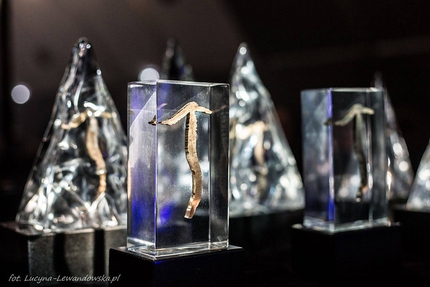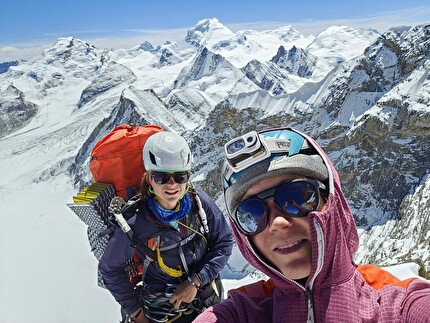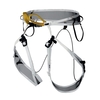Gasherbrum III, Kaqur Kangri & Yashkuk Sar win the Piolets d’Or 2025

 1 / 5
1 / 5 Planetmountain
Planetmountain
The International Jury of the Piolets d'Or has selected three of the climbs achieved in 2024 to bestow this year's main awards. However, it notes that the high values of the Piolets d'Or are shared by many nations and choosing only three ascents was difficult.
The Piolets d'Or will be held for the second time in San Martino di Castrozza, the first location in the Dolomites to host this prestigious event, thanks to the support of Trentino Marketing, the Municipality of Primiero San Martino di Castrozza, the Primiero Community, FPB Cassa di Fassa Primiero e Belluno, ACSM Group, “le Aquile” of San Martino di Castrozza, the local tourism stakeholders, the Trento Film Festival, and under the patronage of the Dolomites UNESCO Foundation.
The three selected climbs are listed below, in no particular order.
Kaqur Kangri (6,859m), Nepal Himalaya
First ascent of the southwest arête (1,670m, 5.10 A0 M7 WI5) of Kaqur Kangri (a.k.a. Kanti Himal), Kanti Himal, October 15–21. Traversed the mountain and descended by the previously unclimbed northwest ridge.
The Kanti Himal, in remote West Nepal, straddles the border with China/Tibet and its highest summit has the Tibetan name, Kaqur Kangri. In 1998, a small Japanese expedition made a reconnaissance of the southern or Nepalese side and were appalled by what they saw, deciding that, for them, there was no feasible route to the summit. It was left to another Japanese expedition to make the first ascent. In 2002, an eight-member team approached through Tibet and successfully reached the top after fixing ropes on the north flank and east ridge. The mountain remained unvisited for the next 22 years.
The only photos of the south face discovered by Americans Spencer Gray, Ryan Griffiths, and Matt Zia showed the top section, leaving the lower half to their imagination. However, the southwest ridge appeared to have the best rock and was sheltered from active serac fall elsewhere on the face. The three walked eight days from the roadhead to a base camp at 4,700m. After acclimatizing on a nearby 6,200m peak, they made a first attempt on the southwest ridge in mid-October, climbing to 5,800m in a day before their stove failed. This forced a descent to the base of the arête to retrieve another stove, after which Zia, deeply affected by recent news of a friend's death, decided not to continue.
Gray and Griffiths returned to the ridge and ascended good granitic gneiss (they shared one pair of rock shoes), ice, and mixed terrain to reach the spectacular crux headwall. This gave eight sustained mixed pitches, climbed over two days through the only appreciable precipitation during the expedition. From a camp on the summit snow field, they reached the top after one hour's walk on October 31, then descended the previously unvisited northwest ridge, and a west- facing slope below, mostly downclimbing with a dozen rappels. They reached the base of the mountain the same day, having completed one of the hardest routes ever ascended in West Nepal.
Jury members agreed this was a technically difficult ascent of an elegant line, carried out in good style, and with a traverse of the mountain. It featured a high level of exploration and provides a pointer to other alpinists that many challenging unclimbed objectives still exist in little visited regions of the Himalaya.
Gasherbrum III (7,952m), Pakistan Karakoram
First ascent of the west ridge of Gasherbrum III, Baltoro Muztagh, via Edge of Entropy (nearly 3,000m base camp to summit), July 31-August 4. Traversed mountain by descending east face and then the normal route (southwest ridge) of Gasherbrum II.
Before August 1975, Gasherbrum III, 48m short of 8,000m, was the highest unclimbed mountain in the world. That month the summit was reached by four members of a Polish expedition. The British mountaineer Alison Chadwick, her Polish husband Janusz Onyszkiewicz, Wanda Rutkiewicz, and Krzysztof Zdzitowiecki, climbed the standard Austrian Route on Gasherbrum II as far as 7,400m. They then traversed below the summit pyramid to reach a high cwm between Gasherbrums II and III, from where they climbed a steep couloir splitting the southeast face of Gasherbrum III. It remains the highest mountain first ascended by women climbers.
Until 2024, there had only been one other ascent – in 2004 by a Basque pair that repeated the original route. However, less known and somewhat underrated was a spirited attempt on the west ridge in 1985 by the British alpinists Geoff Cohen and Des Rubens. From a previously stocked snow cave above the dangerous icefall at 6,900m, they climbed the ridge to 7,400m, bivouacked, then left their gear and set off for the summit. The wind was fierce and the difficulties higher up proved harder than anticipated. At around 7,700m, with time running out and the prospect of an open bivouac with no equipment unthinkable, they retreated.
Fierce winds also presented a major problem to Aleš Česen (Slovenia) and Tom Livingstone (UK) when they went to attempt the ridge in 2022, forcing them to opt for an alternative plan and try the more sheltered northwest face. They were unsuccessful in this, but far more fortunate when they returned to the mountain two years later for another attempt on the west ridge. The pair made three acclimatization climbs, on the last spending a night at 7,000m. They then left base camp on July 31, and two days later regained the 7,000m camp below the start of the west ridge. Next morning they set off up the ridge, stopping for the first night at a little below 7,500m, and for the second at around 7,800m. Unable to erect a tent at the upper site, they were forced into an open sitting bivouac. They then bypassed the headwall via difficult climbing, possibly up to M6 on one pitch, reached the summit, and then descended the original route on the far side of the mountain. After a night spent at Camp 4 (7,400m) on the standard route to Gasherbrum II, base camp was regained on August 6.
The jury felt this to be a long, difficult and committing route on a rarely visited mountain only fractionally below 8,000m. In addition, it was climbed in a light alpine style by a team of two, and a logical descent made of the opposite side of the mountain - a good example that quality adventure over new ground is still possible on the world's highest mountains.
Yashkuk Sar (6,667m), Pakistan Karakoram
First ascent of Yashkuk Sar, Batura Muztagh, via the north pillar - Tiger Lily Buttress (2,000m, AI5+ M6 A0), September 19–23. Traversed the mountain and descended by the upper west face and lower north face.
The little visited Yashkuk Yaz Glacier provided Americans August Franzen, Dane Steadman, and Cody Winckler with the location for their first trip to the Karakoram. Despite the short approach, access is via the Chapursan Valley close to the border with Afghanistan, and on occasions permission has been denied. Prior to the American visit only three parties are known to have climbed from the upper Yashkuk Yaz Glacier, ascending a handful of peaks, the last in 2006. The glacier rises south to a watershed ridge with the Karambar Glacier, where a standout objective is 6,667m Yashkuk Sar I, its north pillar rising a full 2,000m from the West Yashkuk Yaz Glacier.
After establishing an advanced camp on this upper glacier, Franzen, Steadman, and Winckler first climbed a ca 5,300m subsidiary summit of an unnamed 6,084m peak to the north, before making a new route from the southeast on nearby Sax Sar (6,240m, climbed once before from the Karambar). They now felt ready for Yashkuk Sar I, and on September 19 began climbing the hopefully safe haven of the north pillar, the faces to either side regularly swept by large serac avalanches. The first two days were mostly steep ice and snow, with exposed, difficult-to-arrange, bivouacs at 5,600m and 5,900m. On the second of these they witnessed their proposed line - a steep dièdre through the headwall - swept by a huge collapsed mushroom. Failure seemed imminent but the next morning, after a diagonal rappel left, they were able to reach, then start up an alternative line on the left edge of the headwall, stopping part way up at 6,200m to make the "airiest bivouac of our lives". On the 22nd, hard mixed terrain and surreal snow formations led to the summit ridge, where a luxury crevasse afforded a flat bivouac.
Next day, the summit was quickly reached and a descent made by rappelling 600m in a couloir on the west face, then a traverse back over the west ridge to downclimb and rappel the lower 1,000m of the north face, reaching the main glacier that night. They have named their route Tiger Lily Buttress.
The jury was full of praise for this highly committing ascent and descent, and the young team, who embody the spirit of alpinism, searching journals and earth imagery for far-away objectives that push the boundaries of both technical difficulty and exploration.



 Copia link
Copia link


























